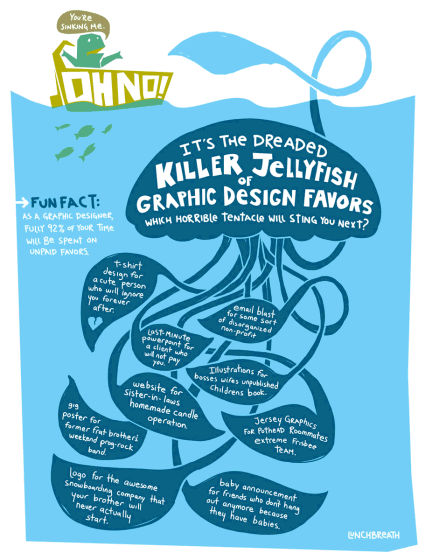
Poster by Tobias Lunchbreath shown on Flickr
- Free work
Many current tweets on Twitter point to a poster by Tobias Lunchbreath, shown on Flickr, in which he lists examples of the work that he is supposed to do for free, as a favor to relatives, friends and organizations. - French email campaign
Pascal Béjean and Nicolas Ledoux, graphic designers from Paris, are circulating by email a protest letter among their french colleagues and ask for signatures. The letter is addressed to institutions that tried to pressure graphic designers to work for free, or for ridiculously low compensation. The french designers association AFD has already been active and publishes a long blacklist of unfair requests for graphic design work. - A cheap logo for the National Endowment for the Arts
NEA, a branch of the US Government charged with promoting artistic excellence, recently needed a new logo, and tried to get it through a competition. The AIGA considered the terms of the competition unfair to graphic designers and sent them a letter of protest. - An even cheaper logo for Twitter
Twitter is said to have paid 6 US$ for the picture of the bird that is seen daily by millions. While there is some discussion about the difference between a picture and a logo, many logo designers are upset. For comparison: The price paid for the notorious London Olympics logo was GBP 400'000 (US$ 600'000). - A ballet invitation
The Joffrey Ballet in Chicago, considered one of the foremost ballet companies in the world, needed someone to design an invitation for a gala performance and got it for 700 US$ by holding an open call to anyone who was interested. The Chicago professional graphic designers were shocked, but the company saw nothing wrong in that procedure, explaining that they pick their dancers in exactly the same way "Participants submit designs, and we pick a winner". - Crowdsourcing and specwork
Crowdsourcing is a method to get work done by offering it in a contest to a large group of people, the crowd, as opposed to hiring a specialist to do it. It is increasingly applied to graphic design: Companies like crowdspring.com or 99designs.com offer a platform where clients who need a graphic design service can specify what they want, and anyone who thinks he can design a logo, a web page, a business card or whatever can submit a proposal. A logo contest will bring typically 100 proposals, one of them will receive typically US$ 300 and the rest nothing, which means that the average participant will have designed a logo for US$ 3 instead of the traditional US$ 3000. No wonder specwork is considered the last resort for the countless unemployed graphic designers, is low in quality and high in plagiarism, and is strongly discouraged by AIGA. - Graphic design - a snooty business ?
The coin has an other side, however. The comment section of the blogs that discuss crowdsourcing contain many entries by satisfied clients testifying that they are perfectly happy with the price/quality mix that they get from Crowdspring. One blog entry argues that the question "crowdsourcing - good or evil?" has become moot when 30'000 designers (some say 200'000, some only 15'000) already participate in it, and adds that the crowdsource revolution has already turned other businesses upside down, like for example stock photography. And Forbes business magazine described the trend last year as ".. slash the cost of graphic design work--and democratize a snooty business", maybe remembering the London logo (but forgetting that snooty newsmagazines could soon become a victim of democratic journalism).
I heard of the problem of specwork the first time in Chaumont two years ago, and thought it had gone away or was restricted to France. Obviously not.